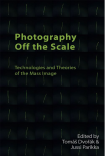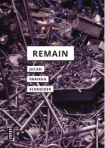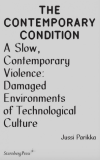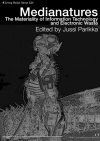Archive
The Kittler e-special is out
 Theory, Culture & Society asked me and Paul Feigelfeld to edit an e-special issue on the work of the German media theorist Friedrich Kittler. We are happy to announce that the issue has now been published and it is the first in a series of e-specials the journal is commissioning. Our issue includes a selection of Kittler’s own articles and texts by other scholars about his work. The articles are open access for a selected period. The issue includes also a new Kittler-translation “Authorship and Love” which is introduced by professor Geoffrey Winthrop-Young.
Theory, Culture & Society asked me and Paul Feigelfeld to edit an e-special issue on the work of the German media theorist Friedrich Kittler. We are happy to announce that the issue has now been published and it is the first in a series of e-specials the journal is commissioning. Our issue includes a selection of Kittler’s own articles and texts by other scholars about his work. The articles are open access for a selected period. The issue includes also a new Kittler-translation “Authorship and Love” which is introduced by professor Geoffrey Winthrop-Young.
We also wrote the introduction to the issue: Kittler’s Media Exorcism (PDF).
Recently also this book Media After Kittler got published, and there is a French translation of Kittler’s software writings forthcoming later this year.
A Parisian Affair: Archéologie des médias et histoire de l’art
France has not really been known for any particular warm academic embrace of media studies despite the otherwise interesting legacies of theories of technology. However, Sorbonne at Paris 3 is running now a seminar on media archaeology, more specifically called “Archéologie des médias et histoire de l’art” convened by Larisa Dryansky together with Antonio Somaini and Riccardo Venturi.
Their list of speakers is very exciting and for its own part demonstrates that there is a body of really interesting work on new technologies and media archaeology in France. A lot of scholars all around the country are working actively on philosophical and historical themes that pertain to media histories and contemporary culture. The Sorbonne series is part of the National Institute of Art History (INHA) and you can download the full programme (as PDF) here.
Besides individual researchers’ work and the recent MCD special issue, also future translations of work such as Friedrich Kittler’s is bound to have an impact on the conversations happening in French. Two Kittler translations are expected to come out in 2015.
“More things in Theory…”: An Interview with GWY
A lovely new interview with Geoffrey Winthrop-Young has been posted online: “More things in theory than heaven and earth are dreaming of.” Conducted by Melle Kromhout and Peter McMurray, it brings out great points. Winthrop-Young is always a pleasure to read, both because of the tone and the insights. Of course, in this case I remain biased, with the focus of the interview being about the so-called German media theory (which is not, as we are reminded, not so German, not pretending to present a big theory nor is it really merely German), Bernhard Siegert, cultural techniques and by the end, also about “media biology”. What’s not to like.
GWY has a fantastic sense of explication when it comes to media theory. When he responds about the subject topic of the interview that “cultural techniques are further installation of modern theory’s crusade against the as such” it both gives a subtle sense of how it maps as part of the contemporary theory landscape (and the persisting enthusiasm for the ontological as suchs) and also reminds me why I feel attracted to cultural techniques and related media analytical directions; I am, after all, a slowly recovering (cultural) historian who does not mind that the notions we operate by, the cultural layers, “all the levels all the way down are made up of historically locatable practices” even if with various twists of complex feedback loops.
Recursions: a new book series in media & cultural theory
 We are proud to announce the launch of a new book series titled Recursions: Theories of Media, Materiality and Cultural Techniques. Placed with Amsterdam University Press, a publisher known for its strong track-record in film and media studies, the series will publish fresh, exciting and important books in media theory. This includes both translations and other volumes that address the core themes outlined below. I am very excited about this project and working with my co-editors Anna Tuschling and Geoffrey Winthrop-Young. We have already some significant projects lined up for 2015 and more forthcoming that we will announce in the coming weeks and months. We are supported by a very strong international advisory board. Get in touch if you want to learn more but first read below for more information!
We are proud to announce the launch of a new book series titled Recursions: Theories of Media, Materiality and Cultural Techniques. Placed with Amsterdam University Press, a publisher known for its strong track-record in film and media studies, the series will publish fresh, exciting and important books in media theory. This includes both translations and other volumes that address the core themes outlined below. I am very excited about this project and working with my co-editors Anna Tuschling and Geoffrey Winthrop-Young. We have already some significant projects lined up for 2015 and more forthcoming that we will announce in the coming weeks and months. We are supported by a very strong international advisory board. Get in touch if you want to learn more but first read below for more information!
New Series Announcement
The new book series Recursions: Theories of Media, Materiality, and Cultural Techniques provides a platform for cutting- edge research in the field of media culture studies with a particular focus on the cultural impact of media technology and the materialities of communication. The series aims to be an internationally significant and exciting opening into emerging ideas in media theory ranging from media materialism and hardware-oriented studies to ecology, the post-human, the study of cultural techniques, and recent contributions to media archaeology.
The series revolves around key themes:
- The material underpinning of media theory
- New advances in media archaeology and media philosophy
- Studies in cultural techniques
These themes resonate with some of the most interesting debates in international media studies, where non-representational thought, the technicity of knowledge formations and new materialities expressed through biological and technological developments are changing the vocabularies of cultural theory. The series is also interested in the mediatic conditions of such theoretical ideas and developing them as media theory.
Forthcoming 2015
- Sybille Krämer – Medium, Messenger, Transmission: An Approach to Media Philosophy.
- Claus Pias – Computer Game Worlds.
Editorial Board
- Jussi Parikka (University of Southampton)
- Anna Tuschling (Ruhr-Universität Bochum)
- Geoffrey Winthrop-Young (University of British Columbia)
Advisory Board:
- Wendy Hui Kyong Chun (Brown University, US)
- Geert Lovink (Hogeschool van Amsterdam, The Netherlands)
- John Durham Peters (University of Iowa, US)
- Thomas Y. Levin (Princeton University, US)
- Marie-Luise Angerer (University of Arts Cologne, Germany)
- Eva Horn (University of Vienna, Austria)
- Markus Krajewski (University of Basel, Switzerland)
- Erick Felinto (State University of Rio de Janeiro, Brazil)
- Adalberto Müller (Federal University of Niterói, UFF, Rio de Janeiro)
- Eivind Røssaak (National Library of Norway)
- Steven Connor (Cambridge University, UK)
- Peter Krapp (UC Irvine, US)
- Antje Pfannkuchen (Dickinson College, PA, US)
- John Armitage (Winchester School of Art, UK)
- Till Heilmann (University of Siegen, Germany)
- Isabell Otto (University of Konstanz, Germany)
- Astrid Deuber-Mankowsky (University of Bochum, Germany)
- Sean Cubitt (Goldsmiths College, London, UK)
- Claus Pias (Leuphana University, Germany)
- Stefan Rieger (University of Bochum, Germany)
- Andrew Murphie (University of New South Wales, Sydney, Australia)
- Axel Fliethmann (Monash University, Melbourne, Australia)
- Yuji Nawata (Chuo University, Tokyo, Japan)
Authors’ information
Proposals welcomed
Proposals for monographs or edited volumes should kindly follow the standard AUP Proposal Form (http://en.aup.nl/en/service/authors) and should also include the envisaged table of contents, an overview of the volume and abstracts of the proposed chapters or articles.
Further information
If you are interested in publishing a book with us please contact Jeroen Sondervan, Senior Commissioning Editor for Film & Media Studies at j.sondervan@aup.nl or one of the series editors.
More information about Amsterdam University Press.
No Such Agency: Kittler on the NSA
Friedrich Kittler’s words seem prophetic, telling the story of metadata and its politically sustained unreachability: “Maybe Jagger was wrong. We can always get what we want, from CDs to cable TV. Just not what we need: information on information. The fact that currents of media desires flow camouflages a situation in which information technology is strategy.
Paul Feigelfeld has done a great thing and translated Friedrich Kittler’s text “No Such Agency” from 1986 into English. What seems a rather visionary move – to talk of the NSA technological surveillance activities in the 1980s already – is just a proof of the German media theorists ability to perceive the intimate link modern forms of intelligence and technology have. Below our short intro to the translation, written together with Paul:
Introduction to Kittler’s “No Such Agency”
by Paul Feigelfeld and Jussi Parikka
German media theorist Friedrich Kittler’s short text on the NSA (National Security Agency) titled “No Such Agency” was originally published in 1986. The German newspaper and online publication TAZ decided to publish the piece from its archives in January 2014, after months of heated discussion about the NSA after the Snowden leaks. What the piece reveals is less the idea that Kittler should be branded a visionary, but that the NSA has a long technological history.
The text is a sort of a review of, or at least inspired by, James Bamford’s book The Puzzle Palace: Inside the National Security Agency, America’s Most Secret Intelligence Organization (1983) and its German translation, NSA. Amerikas geheimster Nachrichtendienst, which came out in German in 1986.
At the time, Kittler had just fought through Aufschreibesysteme: 1800-1900 as his habilitation, and Gramophone, Film, Typewriter was looming. More significantly, however, he had just bought his first computer and taken up programming. Like Kittler, the Arpanet was slowly switching to UNIX and C as a technical standard, before the internet of the 1990s. In Germany during the 1970s, BKA chief Horst Herold had implemented “Rasterfahndung” or dragnet policing as a countermeasure to the RAF (Red Army Faction) threat. And as Kittler demonstrates in his text, the NSA’s role of power in information infrastructures was not a reaction to the internet, but an act of design within those systems.
The piece shows Kittler’s interest in secrecy and the military basis of media technologies – but significantly, it reminds us that the media theorist was always as interested in institutions as their technical networks of knowledge.
 Photographer Trevor Paglen, famous for his photographic mapping of networks and sites of power in the post 9/11 US, and recently his NSA photography, argues how “secrecy ‘nourishes the worst excesses of power’” . But for Kittler, one could say that secrecy is power: the technically mediated possibilities of circulation, restriction and gathering of information way before the Internet and much before Edward Snowden was able to give us a further insight into the extensive contemporary forms of surveillance excessively interested in us humans. For Kittler, however, this already marks the possibility that the information gathering and processing machines are at some point not anymore even interested in human targets: “With the chance of forgetting us in the process.”
Photographer Trevor Paglen, famous for his photographic mapping of networks and sites of power in the post 9/11 US, and recently his NSA photography, argues how “secrecy ‘nourishes the worst excesses of power’” . But for Kittler, one could say that secrecy is power: the technically mediated possibilities of circulation, restriction and gathering of information way before the Internet and much before Edward Snowden was able to give us a further insight into the extensive contemporary forms of surveillance excessively interested in us humans. For Kittler, however, this already marks the possibility that the information gathering and processing machines are at some point not anymore even interested in human targets: “With the chance of forgetting us in the process.”
Read Kittler’s “No Such Agency” here.
A Geology of Media
I am pleased to announce that I have signed a contract with University of Minnesota Press for a new book tentatively called A Geology of Media.
Planned for 2015, A Geology of Media forms the third, final part of the media ecology-trilogy. It started with Digital Contagions: A Media Archaeology of Computer Viruses (2007) and continued with Insect Media (2010). This book on the geophysics and the non-organic ground of media complements the earlier takes by offering a media materialism from the point of view of geological resources, electronic waste and media arts. Through engaging with several contemporary art and technology projects it provides a media theoretical argument: to think of materiality of media beyond the focus on machines and technologies by focusing on what they consist of: the chemistry and geological materials of media, from metals to dust.
In short, I am interested to see if what pejoratively sometimes is called “hardware fetishism” is not hard enough, and even media and cultural theorists need to focus on the rocks and crust that make technical media possible. Earth history of deep times mixes with media history, which becomes a matter of not only thousands, but millions of years of non-linear history (to modify Manuel Delanda’s original idea). This way media materialism becomes a way to entangle media technologies, environmental issues and themes of global labour. Perhaps instead of the Anthropocene, we should just refer to the Anthropobscene.
I’ve been in recent talks and short posts been addressing the geological in media, and my piece in The Atlantic offered a short preview of what’s to come. In addition, below a very tentative table of contents. This project (and the Erkki Kurenniemi book I am working on with Joasia Krysa) will keep me busy for a while.
A Geology of Media
Preface
1) Introduction: Grounds of Media/Culture
2) An Alternative Deep Time of the Media
3) Psychogeophysics of Technology
4) Dust and the Exhausted Planet
5) Media Fossils
Afterwords: Half-Life
Appendix:
“Zombie Media”, by Garnet Hertz and Jussi Parikka
Archaeology
Siegfried Zielinski asked me to write a very short dictionary type of entry on “Archaeology” for an exhibition catalogue. The exhibition will take place at Edith Russ Haus for Media Art in 2014 and they are going to do an exhibition on Zielinski’s AnArchaeologies and Variantologies, including some artistic positions by David Larcher, Herwig Weiser, Anthony Moore and others. Below my contribution.
Archaeology
The 19th century disciplinary invention of “archaeology” has had major impact in and out of academia. Besides the specific methods for investigating the material remains of human cultures, of building on the fragments to create collections, narratives and modes of preservation for a varia of objects and documents, the archaeological imaginary penetrates our audiovisual culture. It persists as an imaginary of itself: the narratives and images of hidden treasures waiting to be ungrounded. And it persists as the conceptual legacy that comes not only from archaeology proper, but also from Immanuel Kant.
Kant’s idea of philosophical archaeology itself ungrounded the idea of conceptual work building on the ruins of earlier philosophers. As Giorgio Agamben argues, this lead to the more fundamental notion of arkhé that refers not to origins, but to command and commencement. In a way that resonates with the media archaeologist Wolfgang Ernst’s understanding of the “arche” in (media) archaeology, this archaic moment is less the historical than the conditioning beginning of any analytical and genealogical investigation. For Agamben “[a]rchaeology is, in this sense, a science of ruins, a ‘ruinology’ whose object, without constituting a transcendental principle properly speaking, cannot really claim to be there as an empirically given totality.”
Such an understanding shifts from archaeology proper to the archaeology of knowledge in Michel Foucault’s sense. It displaces archaeology restricted to material excavations and works it into a method of archival and philosophical conditions of knowledge – its objects, statements and assumptions. With media archaeology as practiced by a variety of scholars from Siegfried Zielinski to Erkki Huhtamo, Thomas Elsaesser to Wolfgang Ernst, and even with Friedrich Kittler’s earlier writings, the material returns at the centre of the archaeological dig. It has many different meanings and ways of adopting to the object of investigation but it insists on irreducibility to the textual.
Indeed, what in archaeology are the methods necessary to approach the time before writing and the document pertains for media archaeologists both to the pre-cinematic as a similar rhetorical field of investigation and to the ontologically important idea of the arche as a command – even a technological command as the starting point for ungrounding media cultural ruins still present.
Cultural Techniques-special issue
Our book-length special issue on Cultural Techniques (Kulturtechniken) is out. Co-edited by Geoffrey Winthrop-Young, Ilinca Iurascu and myself, the special edition in Theory, Culture & Society is a significant introduction to the term that stems from German academic discussions in cultural and media studies. One could say it offers a significant variation on themes familiar from postwar German humanities’ focus on media, technologies and epistemo-ontological questions of culture in a post-representational and post-textual mode.
By way of some significant translations as well as new articles the issue pitches a way to understand cultural reality through its techniques. The usual definition is from Thomas Macho:
“Cultural techniques – such as writing, reading, painting, counting,
making music – are always older than the concepts that are generated
from them. People wrote long before they conceptualized writing
or alphabets; millennia passed before pictures and statues gave
rise to the concept of the image; and until today, people sing or
make music without knowing anything about tones or musical notation
systems. Counting, too, is older than the notion of numbers. To
be sure, most cultures counted or performed certain mathematical
operations; but they did not necessarily derive from this a concept
of number.” (Macho, 2003: 179)
But as the issue demonstrates, there is more in this mix. The multiplicity of positions and inplications is well articulated in Winthrop-Young’s Introduction to the issue. He articulates how not only in Macho, but in different ways in Cornelia Vismann’s and Bernhard Siegert’s work the constitutive role of cultural techniques functions. In fact, could say that this is the German media theory version of the hominization-thesis: how we become humans; how agency is constituted by cultural techniques which allow us to occupy subject positions. Space, enclosures and passages between them is one way to understand the idea:
“Thus the difference between human beings and animals is one that
could not be thought without the mediation of a cultural technique.
In this not only tools and weapons . . . play an essential role; so, too,
does the invention of the door, whose first form was presumably the
gate [Gatter] . . . The door appears much more as a medium of coevolutionary
domestication of animals and human beings.” (Siegert, 2012: 8)
Key here is the way in which cultural techniques process distinctions with material and aesthetic means. In Winthrop-Young’s lucid words, “Procedural chains and connecting techniques give rise to notions and objects that are then endowed with essentialized identities.Underneath our ontological distinctions (if not even our own evolution) are constitutive, media-dependent ontic operations that need to be teased out by means of techno-material deconstruction.” The implications for a range of recent years of theory-debates are intriguing; it refers to the fact how we need to address practices of theory and techniques of theory as part of the work of concepts and philosophy of contemporary culture. Besides it also shows some early ideas that resonate with a post-textual approach to cultural analysis (for instance in Sybille Krämer and Horst Bredekamp’s article).
I was asked to produce a short video abstract of my own contribution. In addition, find below the table of contents.
Special Issue: Cultural Techniques
Edited by Geoffrey Winthrop-Young, Ilinca Iurascu and
Jussi Parikka
Articles
Cultural Techniques: Preliminary Remarks by Geoffrey Winthrop-Young
Culture, Technology, Cultural Techniques – Moving Beyond Text by Sybille Krämer and Horst Bredekamp
Second-Order Animals: Cultural Techniques of Identity and Identification by Thomas Macho
Cultural Techniques: Or the End of the Intellectual Postwar Era in German Media Theory by Bernhard Siegert
After Kittler: On the Cultural Techniques of Recent German Media Theory by Bernard Dionysius Geoghegan
Cultural Techniques and Sovereignty by Cornelia Vismann
The Power of Small Gestures: On the Cultural Technique of Service by Markus Krajewski
Zootechnologies: Swarming as a Cultural Technique by Sebastian Vehlken
From Media History to Zeitkritik by Wolfgang Ernst
Afterword: Cultural Techniques and Media Studies by Jussi Parikka
Review Article
Files, Lists, and the Material History of the Law by Liam Cole Young
A Pioneer of Finnish Media Studies
Aivokuvia sounds much groovier in Finnish than in English; the translation to the word would be “Images of the Brain”. But it also resonates with the idea of “brain scans”, making the term more interesting in English too; a nod to Deleuze’s film theory, but also to the fascination with the materiality of the corporeal brain, interconnected with possibilities of perception and sensation, but also with the cultural-technological framing of it.
idea of “brain scans”, making the term more interesting in English too; a nod to Deleuze’s film theory, but also to the fascination with the materiality of the corporeal brain, interconnected with possibilities of perception and sensation, but also with the cultural-technological framing of it.
Professor Jukka Sihvonen, whose 60th birthday is celebrated by a seminar as well as the launch of his new book Aivokuvia, has always been someone who in his writing incorporated a fantastic sense of the potentials in Finnish language and how to bend it as an active medium itself for the writing of media and film theory. Sihvonen is a major figure on the Finnish scene as well as for my personal development: he was the one who introduced so many of us at the University of Turku, 1990s and onwards, to the theoretical figures of Paul Virilio, Gilles Deleuze, Friedrich Kittler and others. Besides proper names and theorists, he inspired us to engage in a certain mode of thinking: rigorous, but creative; refusing the most obvious questions and answers; a style of thinking in the Deleuze-Guattarian sense of the word. After his Deleuze-course, we spent several extremely long houred sessions with Teemu Taira and Pasi Valiaho excavating A Thousand Plateus in our reading group. Sihvonen spoke about Virilio and video games; he suggested to read Kittler, and made us ponder what this odd German theorist was trying to say in his Kittler-deutsch. Some of us went on to participate in Kittler’s seminars, some in Wolfgang Ernst’s, both at the same address of Sophienstrasse 22. I myself owe so many of my research ideas to his inspiration – insects, for instance. Sihvonen’s interest in Cronenberg was probably initially behind that route.
A bit in tongue in cheek (yes, do not take such branding exercises ever seriously)I have also called him one of the master minds behind a “Turku School of Media Studies“.
The new book Aivokuvia is exemplary of his interests over the years. It is more of a film theoretical book: Aivokuvia ties together the films of Tarkovsky, Bigelow and Cronenberg with the philosophical engines of Deleuze and others. Besides this new book, it is still Konelihan varina [The trembling of the machinic flesh] which is my favourite book of his, and which really as a student inspired me to dive in to theories of media and technology enmeshed in a cultural historical context.
University of Turku is organising the celebration seminar Video: media, taide, teknologia [Video: media, art, technology] as well as the launch of Aivokuvia, published by Eetos-association. I wish I could be there to celebrate. Warm congrats to Jukka. Looking forward already to the next book of his.
Noise Matters
Greg Hainge has a new book out on noise – Noise Matters. As part of the launch, Greg has written a short position statement on noise and asked a number of theorists and practitioners to respond. I was among those, and here briefly my brief intervention on noise, a response to Greg’s position statement on ontology of noise.
Noise
You don’t need an etymology book in your hand to know that noise connects to nausea. Just turn up your stereo loud enough and persist. Loudness turned into noise can make your bowels turn, and sickness overtake your body. A classic function of media: disorientation of the senses. Noise can clear out the room when you want it to. You can clear spaces, push people away if you want. Or make someone wish they were not in the space, when you debilitate their possibility of saying no to sound. Connecting it to psychoanalytic theories of sensation, sound is hard to resist.
Noise connects to contemporary politics, as is well argued by a range of scholars from Steve Goodman to Suzanne Cuzick. Such cultural theory-musicologists as Milla Tiainen have convincingly argued about the multiplicity of sounds that constitute bodies as collectivities of becoming. The continuum between sound-noise is the axis through which to understand the political constitution of contemporary bodies and collectivities. What holds bodies together is affect, but that glue is also a force of push and pull.
What is interesting about noise is that it is emblematic of the emergence of technical media culture. Noise too has a history, and not only in the aesthetic or even urban development sense. Noise has an engineering oriented media archaeology. Imagine the sounds and noises Denis Kaufman, better known as Dziga Vertov, created at the Petrograd Psychoneurological Institute, in the Laboratory of Hearing.
Engineering noise is related to the wider communication theory issue formally formulated in the 1940s: communication takes place always in the presence of noise. Any kind of consideration of the ontology of noise is at least an implicit nod to the fact that noise becomes measurable in the age of technical media. It becomes an issue of epistemology, in a manner that bypasses the semantic understanding of noise. We are not dealing with meaning, but with various frequencies and patterns that define the world of information and sound. Both information and sound are ontologically time-critical: they unfold in time, and in ways that are not only experiential in the sense that phenomenology taught us, but speculative. There is noise everywhere, as Hainge points out, referring to Bogost and the black noise of objects. Even humans are “noisy narrowband devices” as Licklider coined us in comparison to computers.
“Message or Noise?” This was a shorter text by Michel Foucault, and picked up by the media archaeologist Wolfgang Ernst, who has been one of the theorists keen to rescue noise and signals from meaning-based approaches. Instead, in the age of information, even human perception becomes conditioned by the events of signal processing and signal-to-noise ratio in the transmission of mediatic content. This argument by Ernst resonates with a range of material media theory emphases of recent years, including that of Friedrich Kittler. In the age of technical media, we are able to record pure noise as obediently as the harmonious meaningful phrases of poetry, and transmission takes place in a careful engineering of that aforementioned ratio: signal to noise. Hence, it is not a question of message or noise, just that of messages in noise. And noise in messages.





















